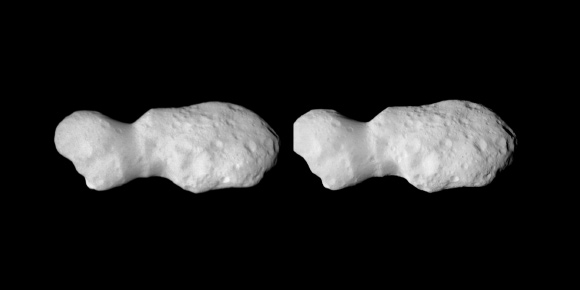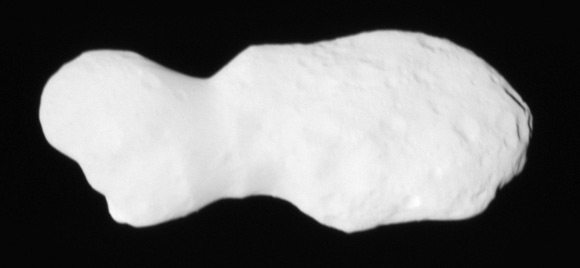NASA’s Lucy mission continues to analyze images collected during the spacecraft’s April 20, 2025 encounter with the carbonaceous asteroid Donaldjohanson.
Donaldjohanson as seen by NASA’s Lucy spacecraft from a range of about 2,700 km (1,700 miles), about 3.2 minutes before closest approach on April 20, 2025. The illumination conditions, with the Sun almost behind Lucy, greatly reduce the contrast of topographic details. Image credit: NASA / Goddard / SwRI / Johns Hopkins APL.
Donaldjohanson is located in the inner regions of Solar System’s main asteroid belt.
This asteroid was first discovered on March 2, 1981, by the American astronomer Schelte Bus at the Siding Spring Observatory.
On April 20, 2025, NASA’s Lucy spacecraft made a close flyby of Donaldjohanson, coming within 960 km (600 miles) of its surface.
The encounter confirmed that the asteroid is an elongated contact binary — an object formed when two smaller bodies collide.
However, members of the Lucy team were surprised by the odd shape of the narrow neck connecting the two lobes, which looks like two nested ice cream cones.

A stereo image pair combining the last complete approach image (right) with a slightly clipped image taken 72 seconds later (left). For a three-dimensional view of the asteroid’s structure, cross your eyes while focusing on the image. Image credit: NASA / Goddard / SwRI / Johns Hopkins APL / Brian May / Claudia Manzoni.
“The newly-released images were taken by the spacecraft’s L’LORRI imager a few minutes before its closest approach,” the researchers wrote in a statement.
“This successful dress rehearsal gives the team high confidence that both the spacecraft and our team are well prepared for the main events: the upcoming encounters with the Jupiter Trojan asteroids.”
“The spacecraft itself is now in a relatively quiet cruise period as it continues traveling through the main asteroid belt.”
“Lucy is heading away from the Sun at more than 50,000 km per hour (30,000 mph).”
“We will keep monitoring the spacecraft as it moves toward the cooler and dimmer outer Solar System.”
“Once Lucy reaches the Trojan asteroids, it will conduct four encounters, observing at least six asteroids — including two satellites discovered by our team — in less than 15 months.”
“The first encounter will be with the asteroid Eurybates in August 2027.”
